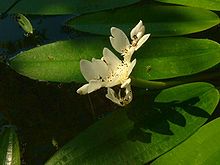Aponogeton distachyos
| Aponogeton distachyos | |
|---|---|
 |
|
| Foliage and inflorescence | |
| Scientific classification | |
| Kingdom: | Plantae |
| (unranked): | Angiosperms |
| (unranked): | Monocots |
| Order: | Alismatales |
| Family: | Aponogetonaceae |
| Genus: | Aponogeton |
| Binomial name | |
|
Aponogeton distachyos L.f. |
|
Aponogeton distachyos or Aponogeton distachyum, also known as waterblommetjie (lit. trans. water-floret), Cape-pondweed, water hawthorn, vleikos and Cape pond weed is an aquatic flowering plant.
Native to South Africa's Western Cape and Mpumalanga provinces, but introduced elsewhere in quiet ponds in warm temperate to subtropical climates in winter rainfall areas. It grows in ponds and vleis which dry up in summer, becoming dormant in the dry summer and growing again when the pools fill with autumn rain.
It is an aquatic plant growing from a tuberous rhizome. The often mottled leaves float on the water surface from a petiole up to 1 m long from the rhizome; the leaf blade is narrow oval, 6–25 cm long and 1.5–7.7 cm broad, with an entire margin and parallel veins. The flowers are produced on an erect spike with two branches at the apex like a 'Y', held above the water surface; they are sweetly scented, with one or two white petal-like perianth segments 1–2 cm long, and six or more dark purple-brown stamens.
The species was described by Carolus Linnaeus the Younger in Supplementum Plantarum 32, 214. 1782 (as "distachyon").
It is widely cultivated in South Africa for its edible buds and flowers, used in the recipe waterblommetjiebredie.
It is also used as an aquarium and pond plant. It was introduced to Europe in the seventeenth century, and later into other parts of the world. It has escaped into the wild and has become widely naturalised in Australia, and more locally in France and England. In North America it is naturalised in southern and western California.
...
Wikipedia
